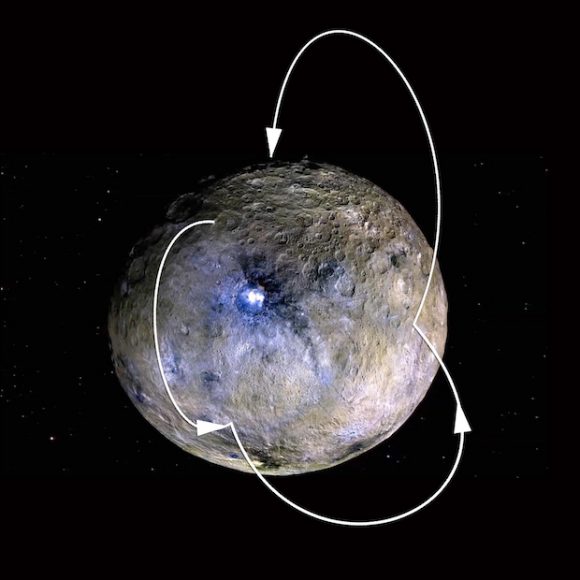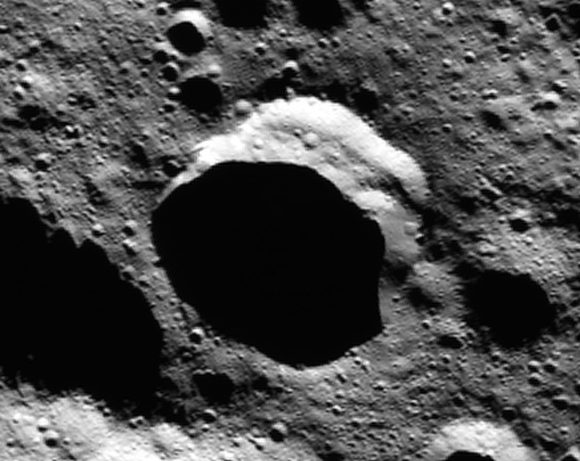As the single-largest body in the Asteroid Belt, Ceres has long been a source of fascination to astronomers. In addition to being the only asteroid large enough to become rounded under its own gravity, it is also the only minor planet to be found within the orbit of Neptune. And with the arrival of the Dawn probe around Ceres in March of 2015, we have been treated to a steady stream of scientific finds about this protoplanet.
The latest find, which has come as something of a surprise, has to do with the composition of the planet. Contrary to what was previously suspected, new evidence shows that Ceres has large deposits of water ice near its surface. This and other evidence suggests that beneath its rocky, icy surface, Ceres has deposits of liquid water that could have played a major role in its evolution.
This evidence were presented at the 2016 American Geophysical Union meeting, which kicked off on Monday, Dec. 12th, in San Fransisco. Amid the thousands of seminars that detailed the biggest findings made during the past year in the fields of space and Earth science - which included updates from the Curiosity mission - members of the Dawn mission team shared the results of their research, which were recently published in Science.

Graphic showing a theoretical path of a water molecule on Ceres. Some water molecules fall into cold, dark craters called "cold traps," where very little of the ice turns into vapor, even over the course of a billion years. Credit: NASA/JPL-Caltech/UCLA/MPS/DLR/IDA
Titled "Extensive water ice within Ceres' aqueously altered regolith: Evidence from nuclear spectroscopy", the mission team's study details how data gathered by Dawn's Gamma Ray and Neutron Detector (GRaND) determined the concentrations of hydrogen, iron and potassium in Ceres crust. In so doing, it was able to place constraints on the planet's ice content, and how the surface was likely altered by liquid water in Ceres' interior.
In short, the GRaND instrument detected high levels of hydrogen in Ceres' uppermost structure (10% by weight), which appeared most prominently around the mid-latitudes. These readings were consistent with broad expanses of water ice. The GRaND data also showed that rather than consisting of a solid ice layer, the ice was likely to take the form of a porous mixture of rocky materials (in which ice fills the pores).
Previously, ice was thought to only exist within certain cratered regions on Ceres, and was thought to be the result of impacts that deposited water ice over the course of Ceres' long history. But as Thomas Prettyman - the principal investigator of Dawn's GRaND instrument - said in a NASA press release, scientists are now rethinking this position:
"On Ceres, ice is not just localized to a few craters. It's everywhere, and nearer to the surface with higher latitudes. These results confirm predictions made nearly three decades ago that ice can survive for billions of years just beneath the surface of Ceres. The evidence strengthens the case for the presence of near-surface water ice on other main belt asteroids."
The concentrations of iron, potassium and carbon detected by the GRaND instrument also supports the theory that Ceres' surface was altered by liquid water in the interior. Basically, scientists theorize that the decay of radioactive elements within Ceres created enough heat to cause the protoplanet's structure to differentiate between a rocky interior and icy outer shell - which also allowed minerals like those observed to be deposited in the surface.
Similarly, a second study produced by researchers from the Max Planck Institute for Solar Research examined hundreds of permanently-shadowed craters located in Ceres' northern hemisphere. According to this study, which appeared recently in Nature Astronomy, these craters are "cold traps", where temperatures drop to less than 11o K (-163 °C; -260 °F), thus preventing all but the tiniest amounts of ice from turning into vapor and escaping.
Within ten of these craters, the researcher team found deposits of bright material, reminiscent to what Dawn spotted in the Occator Crater. And in one that was partially sunlit, Dawn's infrared mapping spectrometer confirmed the presence of ice. This suggests that water ice is being stored in Ceres darker craters in a way that is similar to what has been observed around the polar regions of both Mercury and the Moon.
Where this water came from (i.e. whether or not it was deposited by meteors) remains something of a mystery. But regardless, it shows that water molecules on Ceres could be moving from warmer mid-latitudes to the colder, darker polar regions. This lends further weight to the theory that Ceres might have a tenuous water vapor atmosphere, which was suggested back in 2012-13 based on evidence obtained by the Herschel Space Observatory.

f images from NASA's Dawn spacecraft shows a crater on Ceres that is partly in shadow all the time. Such craters are called "cold traps." Credit: NASA/JPL-Caltech/UCLA/MPS/DLR/IDA
All of this adds up to Ceres being a watery and geologically active protoplanet, one which could hold clues as to how life existed billions of years ago. As Carol Raymond, deputy principal investigator of the Dawn mission, also explained in the NASA press release:
"These studies support the idea that ice separated from rock early in Ceres' history, forming an ice-rich crustal layer, and that ice has remained near the surface over the history of the solar system. By finding bodies that were water-rich in the distant past, we can discover clues as to where life may have existed in the early solar system."
Back in July Dawn began its extended mission phase, which consists of it conducting several more orbits of Ceres. At present, it is flying in an elliptical orbit at a distance of more than 7,200 km (4,500 mi) from the protoplanet. The spacecraft is expected to operate until 2017, remaining a perpetual satellite of Ceres until the end.
Further Reading: NASA, IfA, PSI






No comments:
Post a Comment